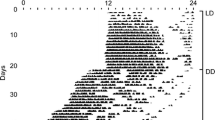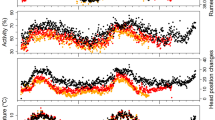Summary
We studied the potential zeitgeber qualities of periodic food availability on the circadian rhythms of locomotor and feeding activity of house sparrows. The birds were initially held in a LD-cycle of 12:12 h, with food restricted to the light phase. After transfer to constant dim light, the birds remained entrained by the restricted feeding schedule. Following an exposure to food ad libitum conditions, the rhythms could be re-synchronized by the feeding cycle. Shortening of the zeitgeber period to 23.5 h resulted in the loss of entrainment in most birds, whereas a longer zeitgeber period of 25 h re-entrained the rhythms of most birds. Although these results prove that periodic food availability can act as a zeitgeber for the circadian rhythms of house sparrows, several features of our data indicate that restricted feeding is only a weak zeitgeber. The pattern of feeding activity prior to the daily time of food access shown under some experimental conditions suggests that anticipation is due to a positive phase-angle difference of the birds' normal circadian system rather than being caused by a separate pacemaker.
Similar content being viewed by others
References
Abe H, Sugimoto S (1987) Food-anticipatory response to restricted food access based on the pigeon's biological clock. Anim Learn Behav 15:353–359
Adler HB (1963a) Sensory factors in migration. Anim Behav 11:566–577
Adler HE (1963b) Psychophysical limits of celestial navigation. Ergeb Biol 26:235–252
Aschoff J (1954) Zeitgeber der tierischen Tagesperiodik. Naturwissenschaften 3:49–56
Aschoff J (1960) Exogenous and endogenous components in circadian rhythms. Cold Spring Harbor Symp Quant Biol 25:11–28
Aschoff J (1965) The phase-angle difference in circadian periodicity. In: Aschoff J (ed) Circadian clocks. North-Holland, Amsterdam, pp 262–276
Aschoff J (1981) Biological clocks in birds. Proc XVII Congr Int Ornithol:113–136
Aschoff J (1987) Effects of periodic availability of food on circadian rhythms. In: Hiroshige T, Honma KJ (eds) Comparative aspects of circadian clocks. Hokkaido Univ Press, Sapporo, pp 19–39
Aschoff J, Goetz C von (1986) Effects of feeding cycles on circadian rhythms in squirrel monkeys. J Biol Rhythms 1(4):267–276
Aschoff J, Pohl H (1978) Phase relations between a circadian rhythm and its zeitgeber within the range of entrainment. Naturwissenschaften 65:80–84
Aschoff J, Saint Paul U von (1990) Circadian rhythms in the bowfly, Phormia terraenovae: control of phase within the range of entrainment. Physiol Entomol 15:129–135
Beling I (1929) Über das Zeitgedächtnis der Bienen. Z Vergl Physiol 9:259–338
Biebach H, Wegner H, Habersetzer J (1985) Measuring migratory restlessness in captive birds by an ultrasonic system. Experientia 41:411–412
Bolles RC, de Lorge J (1962) The rat's adjustment to a-diurnal feeding cycles. J Comp Physiol Psychol 55(5): 760–762
Boulos Z, Rosenwasser AM, Terman M (1980) Feeding schedules and the circadian organization of behaviour in the rat. Behav Brain Res 1:39–65
Coleman GJ, Harper S, Clarke JD, Armstrong SM (1982) Evidence for a separate meal-associated oscillator in the rat. Physiol Behav 29:107–115
Daan S, Aschoff J (1975) Circadian rhythms of locomotor activity in captive birds and mammals: their variations with season and latitude. Oecologia 18:269–316
Edmonds S, Adler NT (1977) Food and light as entrainers of circadian running activity in the rat. Physiol Behav 18:915–919
Enright JT (1965) Synchronization and ranges of entrainment. In: Aschoff J (ed) Circadian clocks. North-Holland, Amsterdam, pp 112–124
Eskin A (1971) Some properties of the system controlling the circadian activity rhythm of sparrows. In: Menaker M (ed) Biochronometry. Nat Acad Sci, Washington DC, pp 55–78
Frim DM, Boulos Z, Moore-Ede MC (1984) Restricted but unsignalled daily food availability synchronizes anticipatory behaviour but fails to entrain other circadian rhythms in the squirrel monkey. Soc Neurosci Abstr 10:504
Frisch B, Aschoff J (1987) Circadian rhythms in honeybees: entrainment by feeding cycles. Physiol Entomol 12:41–49
Honma KI, Goetz C von, Aschoff J (1983) Effects of restricted daily feeding on freerunning circadian rhythms in rats. Physiol Behav 30:905–913
O'Reilly H, Armstrong SM, Coleman GJ (1986) Restricted feeding and circadian activity rhythms of a predatory marsupial, Dasyuriodes byrnei. Physiol Behav 38:471–476
Richter CP (1922) A behaviouristic study of the activity in the rat. Comp Psychol Monogr 1:1–55
Sokolove PG, Bushell WN (1978) The chi square periodogram: its utility for analysis of circadian rhythms. J Theor Biol 72:131–160
Stein H (1951) Untersuchungen über den Zeitsinn bei Vögeln. Z Vergl Physiol 33:387–403
Stephan FK, Swann JM, Sisk CL (1979) Entrainment of circadian rhythms by feeding schedules in rats with suprachiasmatic lesions. Behav Neurol Biol 25:545–554
Wahl O (1932) Neue Untersuchungen über das Zeitgedächtnis der Bienen. Z Vergl Physiol 16:529–589
Wever R (1965) Pendulum versus relaxation oscillation. In: Aschoff J (ed) Circadian clocks. North-Holland, Amsterdam, pp 74–83
Zielinski WJ (1986) Circadian rhythm of small insectivores and the effect of restricted feeding on daily activity. Physiol Behav 36:613–620
Author information
Authors and Affiliations
Rights and permissions
About this article
Cite this article
Hau, M., Gwinner, E. Circadian entrainment by feeding cycles in house sparrows, Passer domesticus . J Comp Physiol A 170, 403–409 (1992). https://doi.org/10.1007/BF00191457
Accepted:
Issue Date:
DOI: https://doi.org/10.1007/BF00191457




